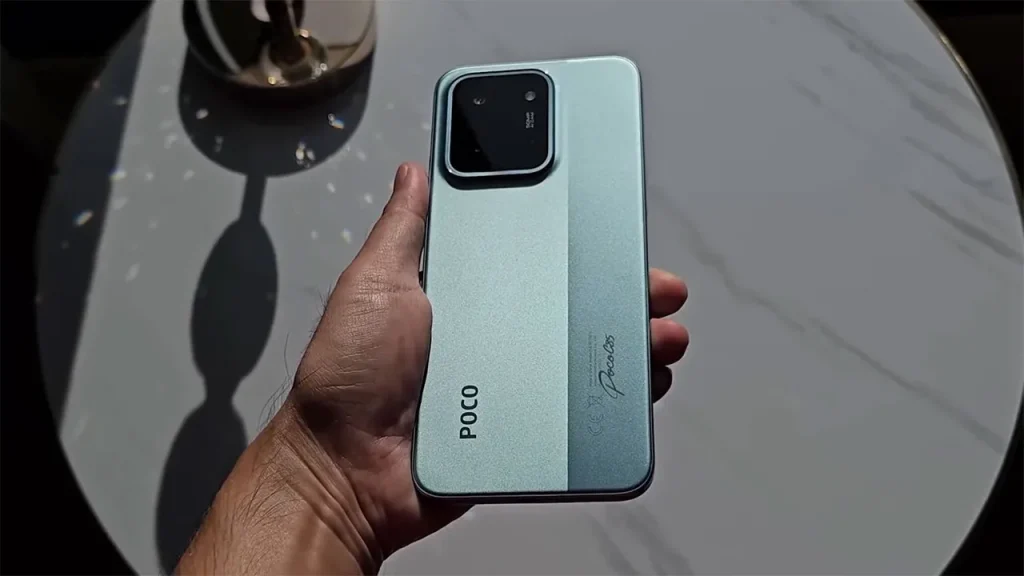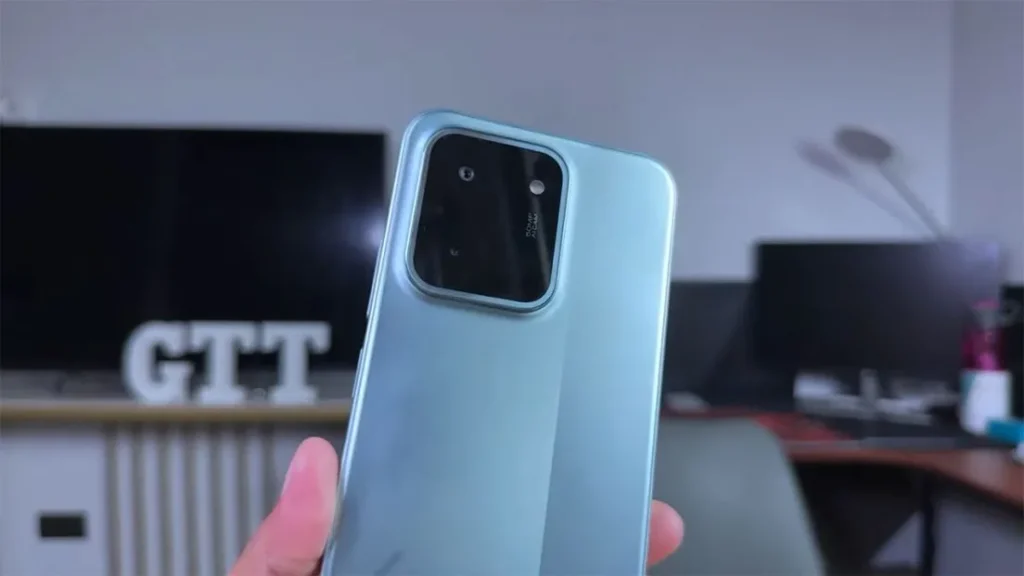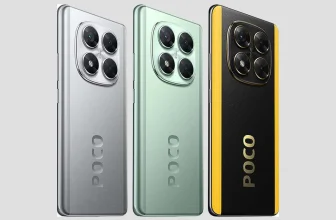
Today we are going to look at one of the latest budget phones from Xiaomi that it has introduced under the Poco brand; the Poco C85. This phone looks very attractive on paper with specifications such as a 6000 mAh battery and a 120 Hz display.
But the main question is; do these attractive numbers on paper really translate into a good user experience in the real world? And most importantly, in a market full of fluctuations where prices go up and down every day, is the Poco C85 worth buying or not? In our review of the Xiaomi Poco C85 phone, we are going to answer all these questions.
Xiaomi Poco C85 Design Review
| Design Feature | Description |
|---|---|
| Build Quality | Premium feel with flat frames and modern design |
| Materials | Plastic body with dual matte/glossy finish |
| Dimensions | 8mm thickness, 205 grams weight |
| Color Options | Black, Green, Purple |
| Durability | IP64 certified – dust and water splash resistant |
| Audio | 3.5mm headphone jack included |
| Battery Impact | Weight increase justified by large 6000mAh battery |
| Market Strategy | Rebranded Redmi 15C for cost efficiency |
When you first hold the Poco C85 in your hand, it does not give you the feeling of a budget phone. The design of this phone is completely up-to-date and similar to more expensive phones and uses flat frames that are very fashionable these days. Of course, we should point out that the Poco C85 is actually a rebranded version of the Redmi 15C. This strategy helps the company reduce design and production costs and ultimately, deliver the product to the consumer at a more competitive price.
The dimensions of the Poco C85, with a thickness of 8 mm and a weight of 205 grams, seem quite appropriate. Although this phone is heavier than its predecessor, the Poco C65, which weighed 192 grams, this increase in weight is completely logical and justifiable, considering the larger 6,000 mAh battery. The body of the phone is made of plastic, but the back panel has a dual matte and glossy design, which gives it an attractive appearance. The Poco C85 is available in three colors: black, green, and purple, so users can choose according to their taste.
One of the biggest advantages of this phone in its price range is having an IP64 certificate, which means it is resistant to splashing water and dust. This feature greatly eases the user’s mind in conditions such as rain or dusty environments and is a big advantage for this budget phone. Also, the presence of a 3.5 mm headphone jack on the bottom edge of the phone is good news for all those who still use wired headphones and do not want to migrate to the world of dongles and Bluetooth headphones.
Xiaomi Poco C85 Screen Review
The Poco C85 screen is one of the most attractive parts of this phone, because with a large 6.9-inch panel and a 120 Hz refresh rate, it wants to offer a smooth user experience to the audience. This high refresh rate makes navigating menus, switching between apps, and scrolling through web pages feel incredibly smooth and gives you the feel of a premium phone.
But there’s a major trade-off to be aware of. The Poco C85 uses an IPS LCD panel with an HD+ resolution. On a 6.9-inch display, HD+ resolution means a lower-than-ideal pixel density (around 254 pixels per inch). This means images, text, and icons may not be as sharp and clear as on Full HD displays, and the difference will be especially noticeable for those used to phones with higher-quality displays. In effect, Poco has sacrificed smoothness for clarity.
However, the Poco C85’s display has other advantages. Its maximum brightness reaches 810 nits in HBM (High Brightness Mode). This brightness is sufficient for outdoor use and direct sunlight, although it may not be as bright as flagship AMOLED displays. The panel is also TÜV Rheinland certified for reducing blue light and preventing eye fatigue, which is a very useful feature for long-term use, especially at night. It should also be noted that the notch at the top of the display for the selfie camera is U-shaped or teardrop, which is an older design than punch-hole notches, which is not too surprising considering the price of this phone.
| Feature | Poco C85 Display |
|---|---|
| Size | 6.9-inch |
| Panel Type | IPS LCD |
| Refresh Rate | 120 Hz |
| Resolution | HD+ (720 x 1600) |
| Pixel Density | ~254 PPI |
| Peak Brightness | 810 nits (HBM) |
| Key Advantage | Very smooth scrolling and navigation |
| Main Drawback | Lower sharpness and clarity due to HD+ resolution on a large screen |
| Notch Design | U-shaped / Teardrop |
| Certification | TÜV Rheinland (Low Blue Light) |
Xiaomi Poco C85 Battery Review
In the battery department, the Poco C85 is a real treat. It is equipped with a gigantic 6000mAh battery, which is one of the largest batteries available in the smartphone market. According to Poco, this battery can guarantee you up to 82 hours of music playback, 22 hours of video playback and more than two days of normal use.
But a large battery alone is not enough, charging speed is also important. The Poco C85 supports 33W fast charging and can charge the phone from zero to 50% in 31 minutes. This speed is truly unmatched for a budget phone and is a huge competitive advantage. The phone also supports 10W reverse charging, which allows you to use the Poco C85 as a power bank to charge other devices.
| Feature | Poco C85 |
|---|---|
| Battery Capacity | 6000 mAh |
| Battery Life (Claimed) | 82h music, 22h video, 2+ days normal use |
| Charging Speed | 33W Fast Charging |
| Time (0 to 50%) | 31 minutes |
| Reverse Charging | Yes, 10W |
Xiaomi Poco C85 Camera Review
The Poco C85 is equipped with a dual camera system that includes a 50-megapixel main sensor and a QVGA depth sensor. The selfie camera also has an 8-megapixel sensor that is located in the U-shaped notch of the display. On paper, the 50-megapixel sensor looks very attractive, but let’s see how it is in practice.
Xiaomi Pad 7 Pro Tablet Review
But the truth is that the quality of the photos depends on many factors, such as the size of the sensor (1/2.76 inches) and the image processor. According to the tests, the main camera takes acceptable photos in good lighting conditions, but to capture fine details or take photos in low-light environments, you should be patient and do not expect great results. Compared to competitors like the Redmi Note 13, which has a 108-megapixel main sensor, the Poco C85 performs poorly in the camera department.
But the biggest weakness in the camera department is the QVGA depth sensor. This extremely low-resolution sensor is practically useless and is designed more to fill the camera module space and be visually appealing than to be a practical tool. For this reason, its presence should not be considered an advantage. In the video recording section, both the main and selfie cameras are capable of recording 1080p video at 30 frames per second, which is quite standard and acceptable for a budget phone.

Xiaomi Poco C85 Hardware Review
The beating heart of the Poco C85 is the 12-nanometer MediaTek Helio G81 Ultra chip, which consists of an octa-core processor with two powerful Cortex-A75 cores clocked at 2.0 GHz and six low-power Cortex-A55 cores clocked at 1.8 GHz. Alongside this processor, the Mali-G52 MC2 graphics processor is used, which is quite suitable and reliable for everyday tasks such as surfing social networks, browsing the web, and watching videos.
When it comes to gaming, the phone’s performance in light and medium games like Mobile Legends is smooth and acceptable, but you shouldn’t expect it to run heavy games with high graphics. Tests have shown that the phone lags, slows down, and heats up when running high-pressure games like Diablo Immortal, which indicates the hardware limitations of the phone. In the Geekbench 6 benchmark, the phone scored a single-core score of 408 and a multi-core score of 1364. These scores clearly confirm that the Poco C85 is in the budget category and you shouldn’t expect flagship performance from it.
In the memory section, the Poco C85 is available in two versions with 6 RAM/128 GB storage and 8 RAM/256 GB storage and also supports MicroSDXC memory cards. One of the main weaknesses of this phone in the hardware section is the use of internal memory with old eMMC 5.1 technology, which has lower read and write speeds than newer technologies such as UFS. This can cause slowness in installing applications and loading games.
In the security section, the Poco C85 uses a fingerprint sensor on the side of the phone, which has acceptable accuracy and speed. Other features of this phone include Bluetooth version 5.4, Wi-Fi 5, and the presence of a Type-C 2.0 port with OTG capability.
Software review of the Xiaomi Poco C85 phone
In terms of software, the Poco C85 is released with Android 15 and the HyperOS 2.0 user interface, which is a big advantage. HyperOS 2.0 brings new and attractive features such as greater personalization of the lock screen, a redesigned Control Center, and improved camera performance with artificial intelligence. However, a big problem here is the presence of a lot of pre-installed apps that can take up almost 30 GB of internal memory. This is a serious challenge for users who buy the 128 GB version and need a lot of storage space. However, it is worth mentioning the interesting Circle to Search feature that Xiaomi has made available for the Poco C85, a feature that was previously only seen on flagship phones from Google and Samsung.
Xiaomi Poco C85 Speaker Review
The Poco C85 is equipped with a single speaker located on the bottom edge of the phone. Poco claims that it can increase the speaker volume by up to 200%, which can be useful for notifications and playing short clips, but you shouldn’t expect much from it for listening to music or watching high-quality movies.
Is Xiaomi Poco C85 worth buying?
| Specification | Poco C85 | Redmi 15C | Samsung Galaxy A07 |
|---|---|---|---|
| Processor | MediaTek Helio G81 Ultra | MediaTek Helio G81 Ultra | MediaTek Helio G99 |
| Display Type | IPS LCD | IPS LCD | PLS LCD |
| Display Resolution | 720×1600 (HD+) | 720×1600 (HD+) | 720×1600 (HD+) |
| Refresh Rate | 120 Hz | 120 Hz | 90 Hz |
| Battery | 6000 mAh | 6000 mAh | 5000 mAh |
| Charging Speed | 33W | 33W | 25W |
| Main Camera | 50 MP + QVGA | 50 MP + QVGA | 50 MP + 2 MP |
| Internal Storage | eMMC 5.1 | e |
Now that we have examined all the parts of Poco C85, it is time to move on to the final summary and see who this phone is suitable for and how much it is worth buying compared to its competitors in the market. Poco C85 is considered a budget phone in the market. This phone is a direct competitor to models like Redmi 15C and Samsung Galaxy A07. It is interesting to know that Poco C85 and Redmi 15C are almost the same phone and have completely similar hardware and software specifications. Therefore, choosing between these two models depends mostly on price, warranty and your taste.
Strengths of Poco C85:
A gigantic 6000 mAh battery: An unrivaled champion in the charging section that can easily last up to two full days on a single charge.
- 33W fast charging: Excellent charging speed for a budget phone, which makes you spend less time waiting for the phone to charge.
Large 6.9-inch display with 120Hz: This combination provides a very smooth and enjoyable experience for watching content and browsing the web. - Water and dust resistance (IP64): A valuable feature that is rarely seen in this price range.
- 3.5mm headphone jack: This is a big advantage for users who still use wired headphones.
POCO C85 Weaknesses: - Low HD+ resolution: The low resolution for a large 6.9-inch display means that images and text are not as sharp as they should be.
- Average hardware performance: The Helio G81 Ultra chip is sufficient for everyday tasks, but lags and slows down for heavy games.
- Slow internal memory: Using the older eMMC 5.1 technology instead of UFS reduces data transfer speeds.
Too much pre-installed software: Pre-installed apps taking up a lot of storage space is a serious problem. - QVGA camera sensor: This sensor is practically useless and is mostly decorative.
Poco C85 vs Redmi 15C: These two phones are almost identical in terms of hardware and software specifications, as the Poco C85 is actually a rebranded version of the Redmi 15C. Therefore, choosing between these two models depends more on the current price in the market and the terms of warranty and after-sales service.
Poco C85 vs Samsung Galaxy A07: The Samsung A07 is available in the market at a lower price and uses a newer and better processor (Helio G99) that outperforms the Poco chip (Helio G81 Ultra) in both performance and power consumption. But in contrast, the Poco C85 has clear advantages; The 6,000mAh battery (vs. the A07’s 5,000mAh) and 120Hz display refresh rate (vs. the A07’s 90Hz) provide a smoother user experience. The Poco C85 is also IP64 certified, while the A07 is IP54 certified. The final conclusion is that; with its focus on battery and large, smooth display, the Poco C85 is a great choice for users who prioritize charging and watching content. In contrast, the Samsung A07, with its more powerful processor, offers better performance for everyday use and multitasking, and considering its lower price, it is a very good value for money.



